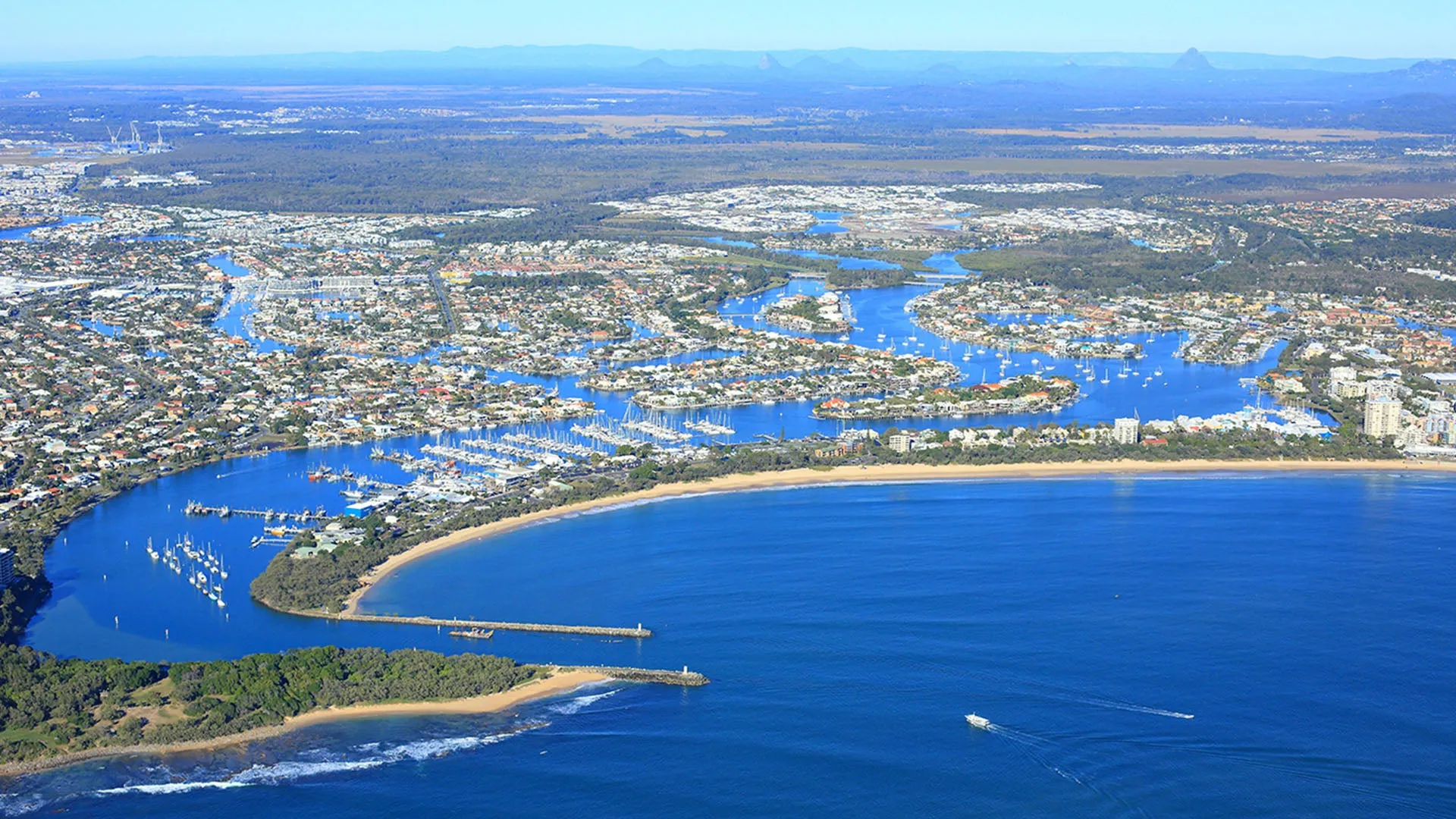Canals
Find out about your responsibilities while living on a canal.

Canals are constructed waterways that are fully tidal and not connected to weirs or locks. There are 6 systems in the Sunshine Coast region:
- Maroochy Waters canals – mostly sandy canal
- Minyama-Buddina canals – mostly sandy canal
- Mooloolaba canals – mostly sandy canal
- Mountain Creek (Hideaway) canals – mostly sandy canal
- Wurtulla canal – rock canal
- Lamerough canal – rock canal.
Maintenance responsibility for these canals is split between the property owner and council.
The residents' handbook: artificial waterways (PDF, 1.01MB) answers some common questions about your responsibilities, and how you can help keep your canal or waterfront property clean, healthy and well-maintained.
Council’s maintenance responsibility
We are responsible for maintaining the area in front of the revetment wall down to the other side of the canal – which is called a profile. Not the revetment wall.
Our role is to keep the canal clean, filled with water and navigable.
To do this, we follow a maintenance program.
Canal maintenance program
Each canal system was originally designed and constructed with either sand or rock profiles (some sand canals have a mix of both).
Our maintenance focuses on keeping today’s canal profiles as close as possible to the original design.
To do this, excavators, barges and/or dredges may need to move sand around in the canals to reinstate the profile back to its original design. It may also include removing vegetation from the profile or installing additional rock.
Timing: This occurs approximately every 3 to 4 years.
Canals are owned by the Queensland Government; however, the Coastal Protection and Management Act 1995 gives responsibility of maintenance of the canal to local governments. This means we must have approval from the state to do any work in the canal systems.
Refer to map below for scheduled maintenance dates for canals. Click on a line segment adjacent to a parcel to view more information.
Canal maintenance review 2020
In 2020, an independent review of council’s maintenance program took place and resulted in changes being made. The review found that council was meeting its responsibilities, but some changes would increase efficiencies and benefit our environment. The review recommended:
- reinstating the original beach profile
- removal of all vegetation, rubbish and debris from the profile
- revert back to rock profiles to all properties that had rock treatment in the original profile
- an audit of unapproved private structures – with the view to request property owners with an unregistered structure to apply for approval to keep their structure or remove it
- continue with the de-silting program
- undertake regular surveys.
For further details on the outcomes of the review, see the full report (PDF, 14.84MB).
Property owner’s maintenance responsibilities
Read the residents' handbook: private structures in canals (PDF, 13.39MB) for tips on how to keep your revetment wall, jetty, pontoon, deck and boat ramps in good condition.
This handbook is general in nature and not intended to provide legal, engineering, building or other professional advice.
Revetment wall
You, the property owner, own the revetment wall in front of your property and are responsible for maintaining it.
Private structures - pontoons, jetties, boat ramps and decks
You are also responsible for maintaining other private structures connected to your property including pontoons, jetties, boat ramps and decks.
Sand profiles around private structures
This includes managing the sand profiles around these structures - for example, if your pontoon is sitting on sand, it would be your responsibility to manage this. For further information on this, please see independent advice from a suitably qualified professional, such as a private coastal engineer or environmental consultant.
New private structures
An operational works application must be submitted to do work within a tidal canal. Find out more from development services.
Canal cross sections and surveys
To help you with maintenance of your private structures, here are the typical cross-sections and most recent surveys of each canal.
| Typical cross sections | Surveys | |
| Maroochy Waters canals – mostly sandy canal | Maroochy Waters - typical cross section (JPEG, 1.88 MB) | Maroochy canal - survey November 2025 (PDF, 4.31 MB) Maroochy canal - survey October 2024 (PDF, 9.81 MB) |
Minyama-Buddina canals – mostly sandy canal | Baralong and Paringa canal - cross section (PDF, 2.04 MB) Bombala canal - cross section (PDF, 3.72 MB) Jessica Haven canal - cross section (PDF, 4.87 MB) Lock Laws canal - cross section (PDF, 4.04 MB) Mulloka and Myambla canal - cross section (PDF, 2.47 MB) | Minyama-Buddina canals contours - survey 2024 (PDF, 6.01 MB) Minyama-Buddina canals cross section - survey 2024 (PDF, 6.01 MB) 2023 Kawana canal (PDF, 2.95MB) 2023 Myuna canal (PDF, 1.22MB) 2022 Paringa canal (PDF, 3.85MB) |
| Mooloolaba canals – mostly sandy canal | Mooloolaba canals - typical canal cross section (TIF, 70.75 KB) | Mooloolaba canals contours - survey October 2024 (PDF, 12.66MB) Mooloolaba canals Cross-Sections - survey October 2024 (PDF, 12.66MB) |
Mountain Creek (Hideaway) canals – mostly sandy canal | Mountain Creek - revetment wall cross section (PDF, 326.13 KB) Mountain Creek - typical cross section (TIF, 78.08 KB) | Mountain Creek - survey October 2024 (PDF, 9.63 MB) |
